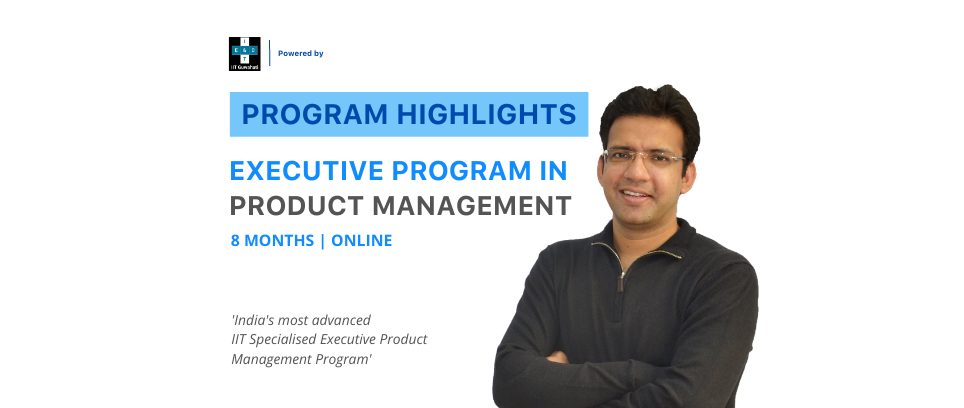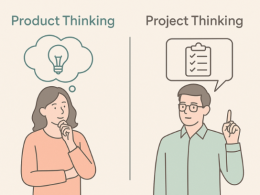Is the legendary “IIT” tag familiar to you?
Does it ignite a spark of excitement, knowing it elevates your status and career trajectory?
Imagine a life without it—certainly not the same!
The “IIT” tag in India signifies the most acclaimed and esteemed group of tech enthusiasts. The moment people discover you’re an IITian, they’re drawn in, eager to know the secrets of becoming one or how to prepare for this prestigious journey. And when such moments arrive, one can’t help but feel invincible, on top of the world!
We present you with an outstanding opportunity to enrich your career with the esteemed IIT credentials, irrespective of your educational background. We are delighted to introduce the Executive Program in Product Management, offered in collaboration with the E&ICT Academy at the prestigious Indian Institute of Technology, Guwahati.
Embrace this unique chance to elevate your management skills and expertise under the guidance of IIT’s renowned faculty and cutting-edge resources.
Don’t miss the chance to take your product management career to new heights with this exclusive program.
IIT Guwahati has been ranked 7th in Engineering and 8th in the Overall Category in the NIRF India Rankings 2021. It is a public technical university established by the Government of India and located in Amingaon, North Guwahati, Assam.
In this blog, we will delve into the course details. Be sure to save it for future reference and share it with your fellow data enthusiasts!
So, let’s get started.
Program Highlights:
This program is designed for a diverse range of professionals, including software developers, consultants, tech leads, product managers, marketing and sales professionals, project managers, business analysts, engineers, and mid-career professionals.
- Certification: Give your resume the IIT edge
- 8 Months: Weekend Classes
Top Faculty: Learn from top PMs from Google, Amazon etc.
- 120+ Hours: Intensive training
- 100% Live: Instructor-Led Training
- Placements: 100% career assistance
Key Takeaways:
1. Learn Product Strategy
Developing a strategic vision for a product, defining product goals, and aligning them with business objectives.
2. Become a World-Class PM
Understanding the end-to-end product development process, from ideation to launch and post-launch activities.
3. Master Product Roadmaps
Create product roadmaps that outline the product’s future direction, milestones, and feature prioritization.
4. Make Data-Driven Decisions
Utilize data analysis and metrics to inform product decisions, track product performance, and iterate on product features
5. Build a User-Centric Mindset
Learn how to put the user at the center of product development. This involves empathy and understanding of user needs.
6. Unlock Product Roles
Get ready for roles like Associate Product Manager, Product Manager, Senior Product Manager, or Product Owner.
Master Product Management Tools

Program Syllabus
The Executive Program in Product Management includes the following modules:
Term 1: Introduction to Product Management
Module 1 – Roles & Responsibilities of a PM
- Mindset of PM
- Skills required to be PM
- Key responsibilities of a PM
- Influence without authority as PM
Module 2 – User Research for PMs
- Identifying target user groups
- Quantitative research techniques
- Qualitative research techniques
- How to conduct customer research
Module 3 – Market Research for PMs
- Defining the Target Market
- Identifying & analyzing market trends
- Market Segmentation and Targeting
- Emerging Trends in Market Research
Module 4 – Competitive Analysis for PMs
- Techniques to identify competitors
- Competitive Intelligence for PMs
- Analyzing Competitive Products
- Competitive SWOT Analysis
Term 2: Product Strategy & Roadmap
Module 5 – What is Product Planning Cycle?
- Understanding the product planning cycle
- Brief introduction of PPC elements
- Importance of elemets of PPC
- Flow of PPC
Module 6 – Establishing Product Vision & Mission
- What is product vision?
- Setting product vision
- What is product-led mission?
- Setting product mission
Module 7 – Formulating Product Strategy & Product Goals
- What is product strategy?
- Setting product strategy
- Understanding and setting product goals
- Activity: Strategy Teardown
Module 8 – What is Product Backlog & Roadmap
- What is the product roadmap?
- Creating roadmap
- Understanding product backlogs
- How to create efficient product backlogs?
Term 3: Design Thinking & UI/UX
Module 9 – Design Thinking for PMs
- Design thinking in PM
- Implementing design thinking
- How does design thinking benefit PM?
- Activity: Design Teardown (Airbnb)
Module 10 – Building MVP – Artefacts, Persona Mapping & PRDs
- How to build an MVP?
- Persona mapping, user journey, & user stories
- Product artefacts
- What are PRDs?
Module 11 – UI/UX for PMs
- What is UI/UX?
- Building products with good UX
- Tools for UI/UX design
- Case study about Product UX
Module 12 – Designing Mockups, Wireframes, & Prototypes
- What are Mockups?
- What are Wireframes?
- What are Prototypes?
- Activity: UI/UX Wizard
Term 4: Agile Product Engineering
Module 13 – Introduction to Engineering for Product Managers
- What is Product Engineering?
- The mindset of technical PM
- Should PM learn to code?
- Technical concepts for PM
Module 14 – Understanding Microservices & Cloud Services
- What are Microservices & Cloud Services?
- What is System Design?
- Understanding content delivery network
- Native apps & hybrid apps
Module 15 – Waterfall & Agile Methodology
- What is Waterfall methodology?
- What is Agile methodology?
- Traditional Vs Agile
- Levels of Planning in agile methodology
Module 16 – Understanding Scrum & Kanban
- Agile Frameworks
- What are Scrum and Kanban?
- Tools for Scrum & Kanban
Term 5: Product Marketing & Launch
Module 17 – Product Development & Planning User Tests
- Creating story & Planning sprint
- Task breakdown & preparing documentation
- Planning, Recruiting, & Preparing for the test
- Conducting tests & Analyzing data
Module 18 – Product Launch & A/B Testing
- Risk Analysis
- A/B Testing
- Customer Feedback mechanism
- Case study
Module 19 – Data-Driven Product Marketing & Consumer Behaviour
- What is Product Marketing?
- Go-to-Market
- Growth Hacking & Sales strategies
- Understanding Consumer behavior
Module 20 – Measuring Brand & Impact of Product Marketing
- Importance of brand
- Building brand
- Understanding brand management
- Measuring Impact of product marketing activities
Project: Design Discovery
Design Discovery requires one to apply design thinking concepts to create
human-centered and action-oriented solutions. As a PM practitioner, you will
be competing with the best to solve a complex challenge.
Term 6: Growth & Scaling
Module 21 – Driving Product Growth
- What is product growth?
- Product-led growth for organization
- Product-led growth frameworks
- Case study
Module 22 – Who is a Product Growth Manager?
- Who is a Product-Growth manager?
- Essential Skills for Growth PM
- Duties of growth PM
- Future as growth PM
Module 23 – Product Growth Strategies
- What are product growth strategies?
- Product growth strategies
- Measuring the performance of product growth strategies
- Case study
Module 24 – Audience & Channel for Growth
- Choosing an audience for growth
- Different channels of growth
- Aligning audience, channels & growth strategies
- Case study
Term 7: Product Monetization
Module 25 – Understanding Product Monetization
- What is product monetization?
- Why focus on monetization as PMs?
- Importance of product monetization
- Financial analysis of product organization
Module 26 – Decoding Buyer Psychology
- What is Buyer Psychology?
- Analyzing consumer purchasing behavior
- How to influence buyer psychology?
- Understanding paths to purchase
Module 27 – Product Pricing Models & Strategies
- What is the Pricing?
- Product pricing, models & strategies
- Service pricing models & strategies
- Key points to consider when pricing
Module 28 – Measuring Product Monetization Success
- Understanding KPIs: CAC, CPA
- Calculating customer lifetime value (LTV)
- Metrics for measuring monetization success
- Case study
Term 8: Product Leadership
Module 29 – Business Strategy
- Introduction to Business Strategy
- Strategic Planning
- Strategic Decision-Making
- Innovation and Business Model Design
Module 30 – Digital Marketing Strategies for Product Leaders
- Introduction to Digital Marketing
- Understanding the basics of SEO, PPC, SMM
- Principles of Conversion Rate Optimization (CRO)
- Analytics and Measurement
Module 31 – Building Product Culture – Team, Stakeholders, Skills
- Importance of Product Culture
- Stakeholder Management
- Product Culture and Organizational Alignment
- Leadership and Influence
Module 32 – Storytelling for PMs
- Crafting a Compelling Narrative
- Building Empathy through Storytelling
- Storytelling in Product Marketing & Cross-functional Collaboration
- Visual Storytelling
Admission Process:
- Apply at iitg.accredian.com
- Pay the Application fee
- Selected Candidates will receive Admission Confirmation Letter.
Start Your Journey Today at E&ICT IIT Guwahati without quitting your job!
 Pin
PinACCREDIAN focuses on teaching and researching cutting-edge technologies such as AI, ML, data science, and product management. By offering industry-specific programs, we aim to equip working professionals with skill sets and transformative learning experiences to advance their careers.
Our mission is to make world-class education accessible and enable high-impact careers for everyone.
Do you have any queries?
Reach out to us at [email protected]
Talk to our Program Mentor at +91 96258 11095






